Hitachi Hma-8500 Mk Ii Stereo Power Amplifier Review
Home Donate NewSearch Gallery Reviews How-To Books Links Workshops Virtually Contact
Hitachi HMA-8500 Mk Two
10 0 WPC MOSFET Stereo Amplifier
(1984-1986)
© 2014 KenRockwell.com. All rights reserved.
Intro Specifications Measurements Usage Recommendations

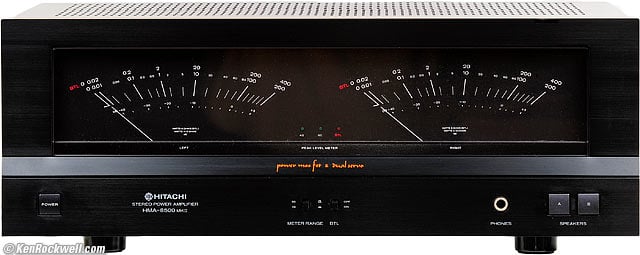
Hitachi HMA-8500 Mk II (rated 100 watts per channel into 8Ω, 35.2 lbs./16 kg, measured 91 watts idle ability draw, about $300 used). enlarge. I got this mine at this link directly to them at eBay (see How to Win at eBay).
This complimentary website's biggest source of support is when you lot use those or any of these links to approved sources when you get annihilation, regardless of the state in which you live — but I receive nada for my efforts if you take the chance of buying elsewhere. I become no regime hand-outs and run no pledge drives to support my research, then please ever use any of these links to approved sources for the best prices, service and selection whenever you go anything. Thanks for helping me aid you lot! Ken.
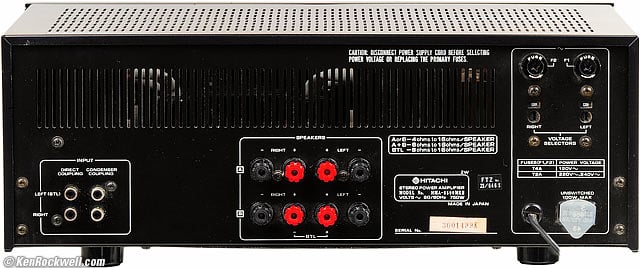
Rear, Hitachi HMA-8500 Mk 2. enlarge.
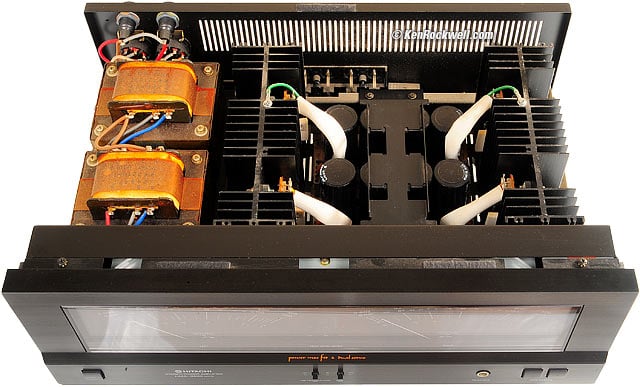
inside the Hitachi HMA-8500 Mk Two. enlarge.
September 2014 Audio reviews all reviews
Introduction summit
Intro Specifications Measurements Usage Recommendations
The Hitachi HMA-8500 Mk Two is a loftier quality 100 watts-per-channel MOSFET class AB stereo power amplifier. MOSFETs are solid-state devices that piece of work on principals more like to vacuum tubes than bipolar transistors — and it sounds groovy!
I've always loved my Hafler DH-200 that I built from a kit in 1981, and when I learned that it uses Hitachi MOSFETs — the same as used in this amplifier — I figured that along with the awesome big meters, that Hitachi might know a affair or 2 about making a proficient amplifier, and so I got this one to review.
It's a existent dual-mono deign. Information technology even has two ability transformers also as 2 sets of power supply rectifiers and capacitors. Each transformer has it's own input voltage selector!
This is a 2014 exam of a 1980s amplifier.
Circuit Design
Information technology's a traditional class AB linear ability amplifier in a perforated canvass metal steel case.
It runs hot; it's biased for form A most of the time. Hitachi discovered a source of distortion was varying capacitance of the output devices near turn-off, so by biasing them more towards class A they eliminated this actress source of baloney
The power rail run at ± 58 VDC.
In that location are two 6800 µF 63 VDC caps and one 1 µF 250v Mylar per rail per channel, total 12 caps and power supply four runway (each channel has independent supplies).
In that location are two pairs of 2SK134 and 2SJ49 in parallel for each channel.
The meters are fed from the headphone feed. The headphones are fed from the speaker rails (earlier the speaker relays) through 333-1/iii ohm series resistors.
The protection relay comes before the headphone takeoff. The protection relay waits v-10 seconds at turn-on, and also trips if at that place is as well mu DC at the outputs.
The meters use a semi-peak one-half wave detector and drive the needles which have VU ballistics.
Meter bulbs are 14 V, 80 mA, 4mm diameter incandescent lamps with leads. I had to supersede mine, and I attempted to match them by DC resistance. Even subsequently doing that, I measured 12.59 V and 12.83 V across the two left bulbs, and 12.78 and 12.96 V beyond the ii correct bulbs. As they age, the voltage differential may increase, and equally either voltage gets higher, that bulb burns out faster. At 13 Five, a fourteen V bulb volition last 14 times longer than it will at 14 V. Bulb life varies inversely as the 12th power of voltage.
History
1977: The HMA-8300 (200 WPC grade G) listed at $750.
1978: The HMA-7500, the worlds first MOSFET power amp with 75 WPC listed at $500; the HMA-8300 (200 WPC) went up to $800.
1980: The HMA-7500 MK II (still 75 WPC MOSFET) is listed at $550, and the HMA-6500 listed at $329.95.
1982: The 7500 MK Ii goes up to $570.
1983: The kickoff HMA-8500 (non Mk II) is 100 WPC MOSFET, 33-1/8 lb. and lists at $700.
1984: This HMA-8500 Mk Ii debuts with 100 WPC into 8Ω or 4Ω, listed as "Sup. B class," 34-7/8 lb, list at $650.
Specifications summit
Intro Specifications Measurements Usage Recommendations
Output Power
Stereo
100 watts per channel.
20~xx,000 Hz at 0.005% THD or
i kHz at 4Ω or 8Ω at 0.005% THD.
130 WPC at 0.v% IEC.
150 W 8Ω dynamic power
Mono (ane channel merely)
200 watts into 8Ω.
Power Bandwidth
5 ~ 100,000 Hz at fifty watts at 0.05% THD.
Sound Input
Two stereo pairs of 1/iv" RCA jacks.
Ane is DC coupled, the other Air-conditioning coupled through an 0.68 µF capacitor.
47 kΩ.
1 V RMS.
SMPTE Intermodulation Distortion
0.005% at fifty Westward.
Frequency Response into 8Ω
0.v ~ 100,000 Hz +0, -1 dB.
Crosstalk
> 75 dB at 20 Hz.
> 85 dB at 1 kHz.
> 65 dB at 20 kHz.
Signal to Noise Ratio
118 dB A-weighted, referred to 100 watts.
This ways < -82.2 dBW or < 219 µV or < -73.2 dBV noise output.
Damping Factor
60 into 8Ω, 20~20,000 Hz.
Power Input
120, 220 or 240 VAC, l-60 Hz.
Rated 260 Due west at ten WPC, 450W/550 VA at 33-1/3 WPC, 750W at 100 WPC.
Actual power consumption.
Quality
Made in Japan.
Size
165 x 435 x 320 mm HWD.
6.5 10 17.1 x 12.6 inches HWD.
Weight
35.25 pounds (16 kg).
Toll, USA
1984: $650 listing price (equivalent to $1,500 today with inflation).
1985: Still lists at $650.
1986: Still at $650.
1987: gone.
2014: about $300 used.
Measurements top
Intro Specifications Measurements Usage Recommendations
Gain Input Levels Channel Balance Power Output
Damping Factors Noise SNR DC Kickoff
Frequency Response Foursquare Waves THD DFD
Headphone Output Meters
Actual Power Consumption Mono Functioning
These measurements were fabricated with a $50,000 Rohde & Schwarz UPL laboratory analyzer. The traces from the Rohde & Schwarz UPL laboratory analyzer are color coded for the Left Aqueduct and for the Right Aqueduct. When they don't lie on top of each other, it's due to aqueduct imbalance. When they do lie on tiptop of each other, the trace turns blue.
Unless otherwise specified, all measurements are RMS, at 1 watt continuous output per channel at 1 kHz with an viii Ω load, both channels driven with a 120 VAC supply line.
Gain measurements top
Stereo
28.93 dB left, 29.00 dB right.
BTL (Bridged mono) Way
In BTL mode, gain is 34.97 dB.
Input Levels measurements meridian
Stereo, 8Ω
101 mV input for one Due west output into 8Ω.
318 mV input for x W output into 8Ω.
1.01 5 for 100 W output at 0.0003% THD into 8Ω.
1.086 Five for 116 W output at 0.1% THD into 8Ω.
i.26 V for 153 W ane mS burst power at 1 burst per second. Meters read 80 Westward peak with 10 mS bursts at 153 W.
Stereo, 4Ω
71.3 mV input for 1 West output into 4Ω.
713.3 mV input for 100 W output into 4Ω.
845 mV input for 135 Due west output at 0.one% THD into 4Ω.
890 mV for 141 W in 10 mS bursts at a rate of 1 burst per second. Meters read 80 W peak.
BTL (bridged mono)
50.iv mV input for one W output into 8Ω.
809 mV input for 251 West output into 8Ω at 0.1% THD at 113.2 or 120 VAC.
Stereo, unloaded
0.0003% THD at 2.8 V out.
0.00033% THD at 36.8 V out.
0.0004% THD at 37.five V out, 1.327 V in.
0.0005% THD at 38 V out, ane.35 5 in.
0.i% THD at 38.five Five out, ane.357 V in at 118.ii VAC.
1% THD at 1.41 V in (118.4 VAC) 39.half dozen V out.
x% THD at 44.two 5 out, 1.77 5 or 118.4 VAC in.
Aqueduct Balance measurements elevation
The correct channel has 0.0724 dB more gain than the left channel.
Power Output measurements superlative
All are continuous RMS measurements at 0.ane% THD at one kHz into 8Ω at 120 VAC unless otherwise noted:
Stereo 8Ω
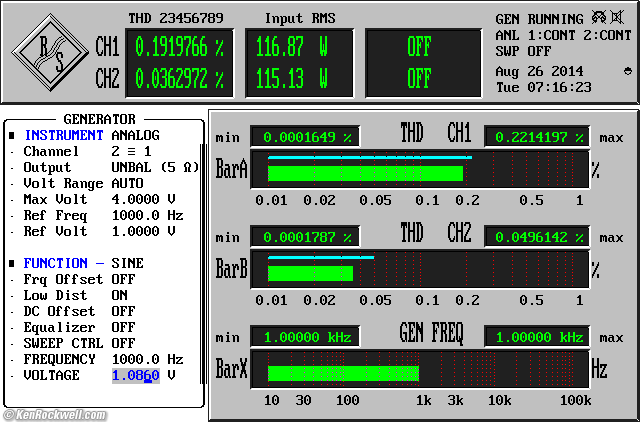
HMA-8500 Mk Two at clipping into 8Ω at one kHz.
116 watts per channel, both channels driven.
Burst Power
Burst power at the point of visible clipping on an oscilloscope for 10 cycle (10ms) bursts at ane kHz is 153 watts RMS.
Stereo 4Ω
Into four Ω, I measure out 135 W at 0.1% THD with 845 mV input.
Into iv Ω, burst power at the bespeak of visible clipping on an oscilloscope for 10 bike (10ms) bursts at one kHz is 141 watts RMS with a 120.6 VAC ability line input.
BTL (mono)
251 W continuous into 8Ω with 113 or 120 VAC power supply, one channel.
Damping Factors measurements top
| Stereo | Output Source Impedance | 4Ω Damping Factor | 8Ω Damping Factor |
| 50 Hz | 68.4 mΩ | 58.5 | 117 |
| one kHz | 68.one mΩ | 58.8 | 117.5 |
| 20 kHz | 76.6 mΩ | 52.2 | 104 |
Output Racket measurements meridian
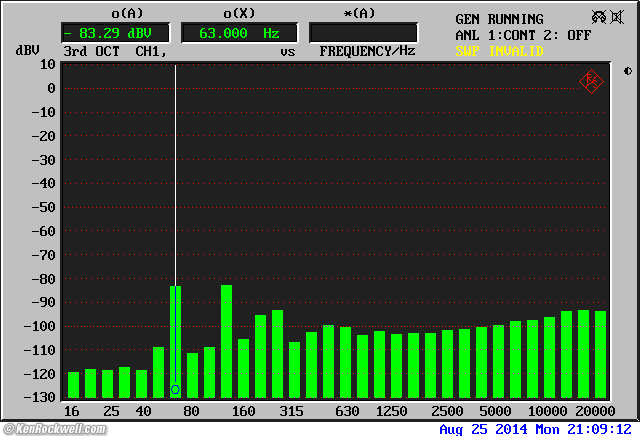
HMA-8500 Mk 2 racket spectral assay.
| A Weighted | Unweighted | |
| Left | -88.1 dBV A | -82.9 dBV |
| Correct | -88.9 dBV A | -83.0 dBV |
Signal to Racket Ratio (SNR) measurements height
97.53 dB A-weighted SNR (fifteen.9 constructive bits) referred to one watt into 8Ω (2.83 V or +9.031 dBV).
117.53 dB A-weighted SNR (19.2 constructive bits) referred to 100 watts into 8Ω (28.28 V or +29.031 dBV).
118.17 dB A-weighted SNR (nineteen.3 effective bits) referred to 116 watts into 8Ω (thirty.46 V or +29.657 dBV).
Output DC Starting time measurements top
+5.seven mV left, +5.9 mV right.
Frequency Response +0, -0.02 dB measurements top
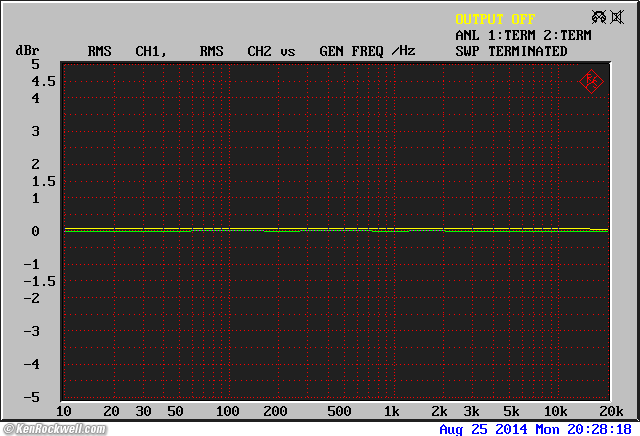
HMA-8500 Mk Ii frequency response, DC input.
Perfect. Let'southward expand the vertical scale:
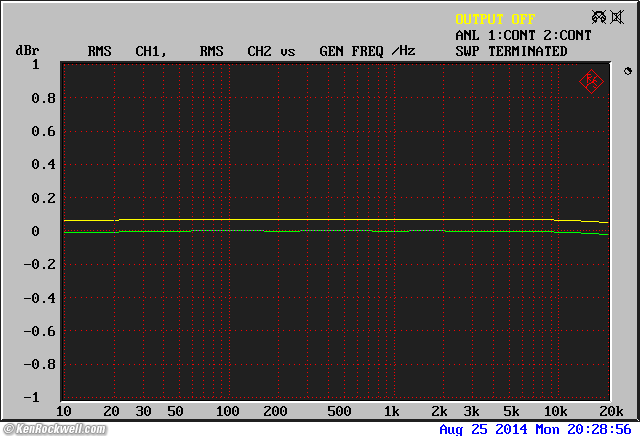
HMA-8500 Mk II frequency response, DC input, expanded scale.
Still perfect except for the slight channel imbalance.
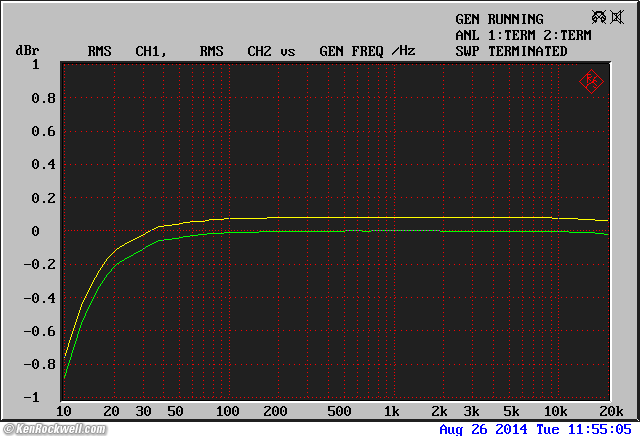
HMA-8500 Mk II frequency response, AC input, expanded scale.
The condenser (AC) inputs are down 0.2 dB at 20 Hz and 0.85 dB at 10 Hz. This is swell.
Allow's aggrandize the vertical scale fifty-fifty more than:
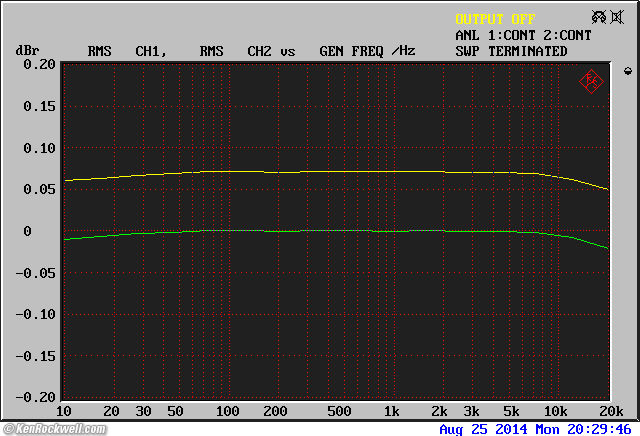
HMA-8500 Mk II frequency response, DC inputs, profoundly expanded scale.
+0.00, -0.02 dB from less than 10 Hz to twenty,000 Hz. Perfect.
The HMA-8500 Mk II has two inputs: a DC-coupled input and an AC-coupled ("Condenser") input. Here are their infrasonic frequency responses:
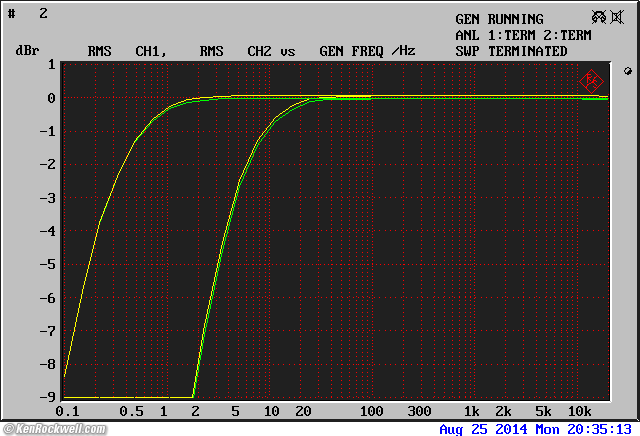
HMA-8500 Mk II infrasonic frequency response, 0.1 - xx,000 Hz. Left curve: DC input. Right curve: Capacitor-Coupled input.
The DC input is -3 dB at 0.27 Hz, while the regular capacitor-coupled input is -3 dB at 4.7 Hz. Apparently the servo circuit that nulls eliminates DC also removes some infrasonics.
Here it is with a larger vertical scale to see the infrasonic attenuation of the regular input:
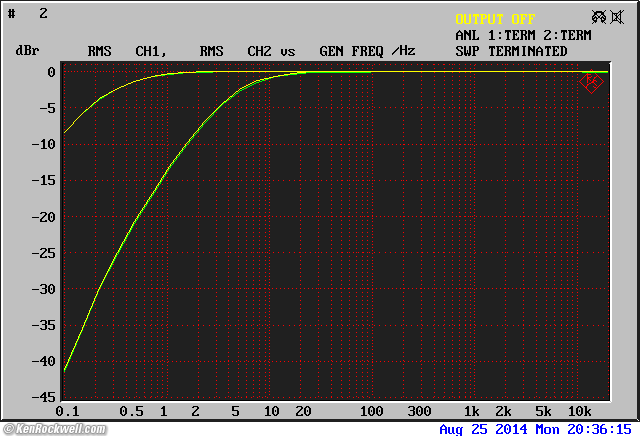
HMA-8500 Mk II infrasonic frequency response, 0.ane - twenty,000 Hz. Left bend: DC input. Right curve: Capacitor-Coupled input.
Hitachi specifies -12 dB at one Hz for the Air conditioning-coupled input, which is exactly what I mensurate.
Let'due south wait at the ultrasonic response to 110 kHz:
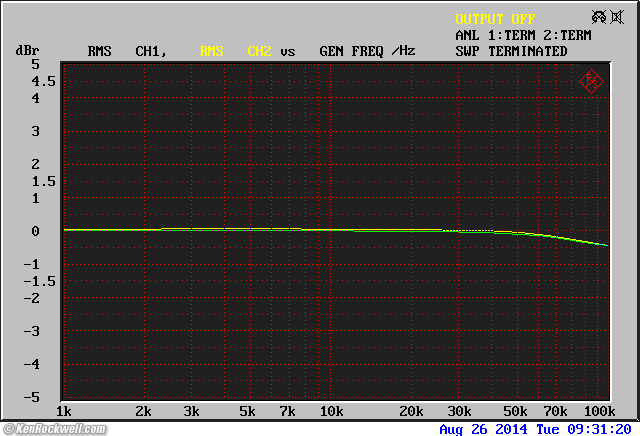
HMA-8500 Mk Two ultrasonic frequency response, ane,000 - 110,000 Hz.
Golly, flat to across 110 kHz. Allow's aggrandize the scale:
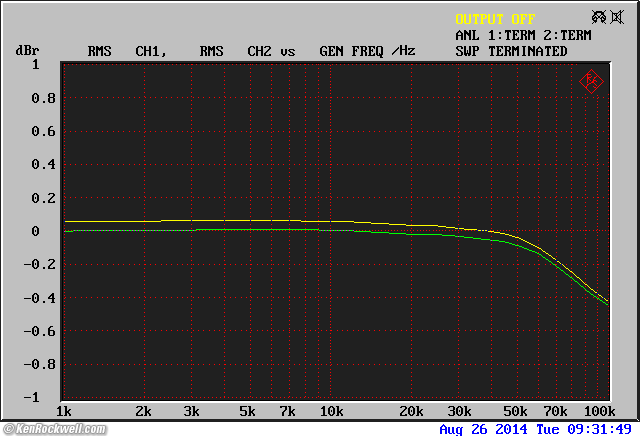
HMA-8500 Mk II ultrasonic frequency response, 1,000 - 110,000 Hz.
Down but 0.four dB at 100 kHz. Good plenty for my ears, and exactly as Hitachi specifies.
This is driving an 8Ω resistor, which doesn't count in the real world. Let'due south run across what information technology does driving a real loudspeaker:
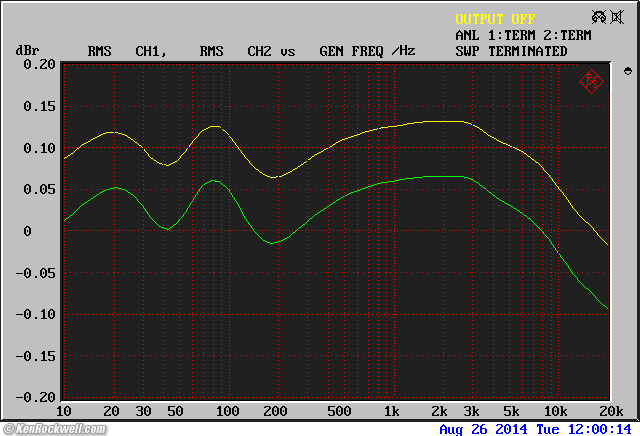
HMA-8500 Mk 2 driving a pair of B&Westward Matrix 805 loudspeakers. 0 dB is the level when driving an 8Ω resistor.
Marvelous, at that place'due south less than ±0.05 dB variation from apartment, the rest is all overall level variations from channel imbalance.
Square Waves measurements acme
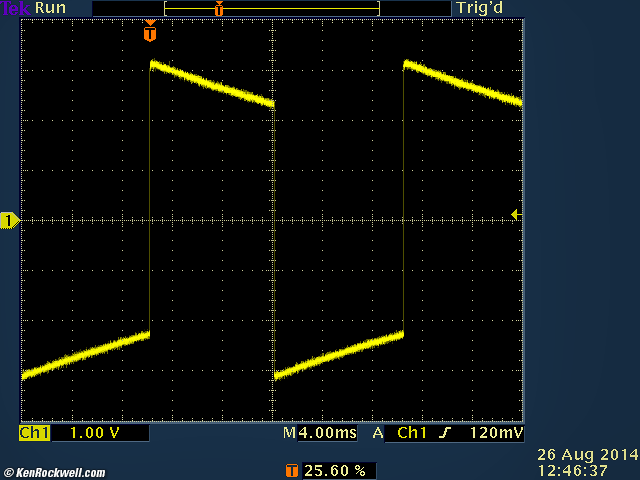
50 Hz square wave, Air conditioning input. (HP 209A, TEK TDS3052.)
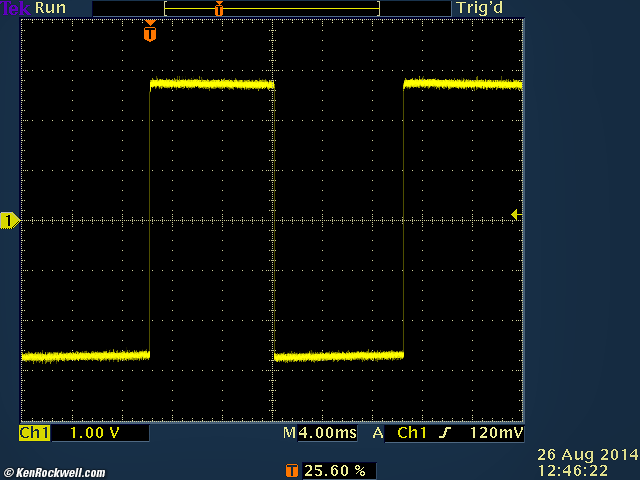
fifty Hz square moving ridge, DC input. (HP 209A, TEK TDS3052.)
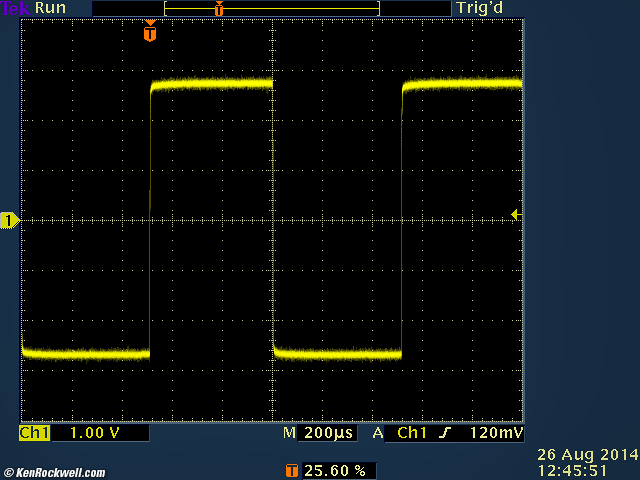
1 kHz square wave, DC input. (HP 209A, TEK TDS3052.)
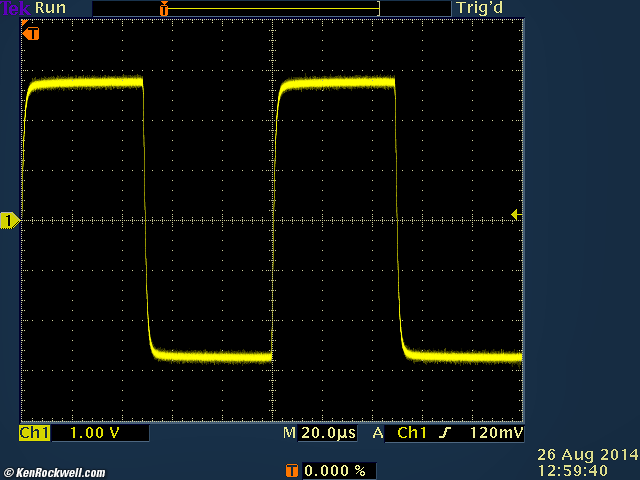
x kHz square wave, DC input. (HP 209A, TEK TDS3052.)
These are perfect. The square moving ridge is supposed to do that when Ac coupled.
THD: 0.0002% (-114 dB) measurements meridian
The Hitachi HMA-8500 MK II has the everyman distortion of whatsoever power amplifier I've ever measured. Only the Sony TA-N77ES comes close.
All these THD measurements are measuring pure distortion components only (THD merely), not noise and distortion (THD+North). THD+N numbers would exist worse than THD alone shown hither.
THD versus output power
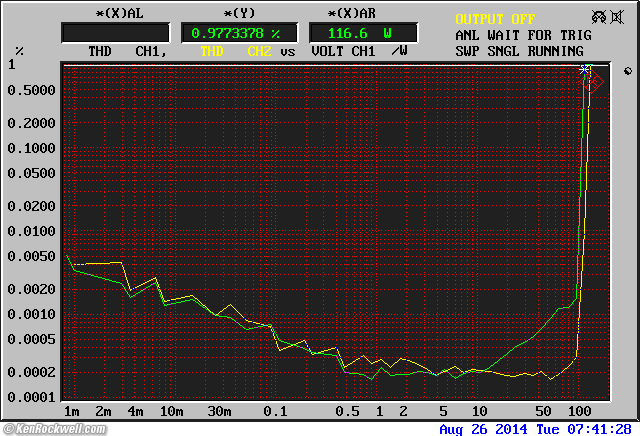
HMA-8500 Mk Ii THD versus output power.
Harmonic Baloney at 10 milliwatts
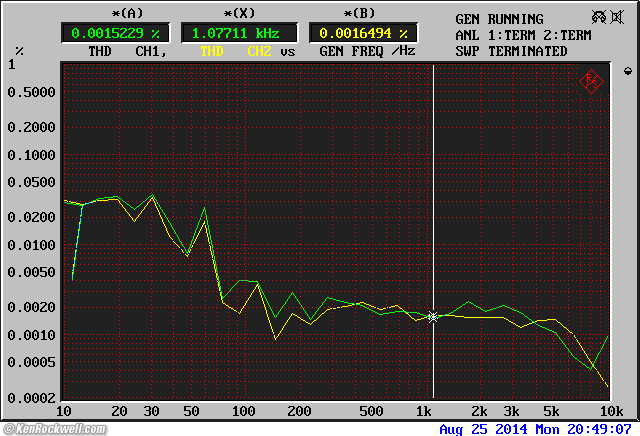
HMA-8500 Mk II THD at ten mW.
At just 10 milliwatts information technology has less THD than near amplifiers at any level. Annotation the expanded scale at the lesser at 0.0002%.
The increased THD at depression frequencies is really the analyzer reading hum at the output.
Harmonic Distortion at ane watt
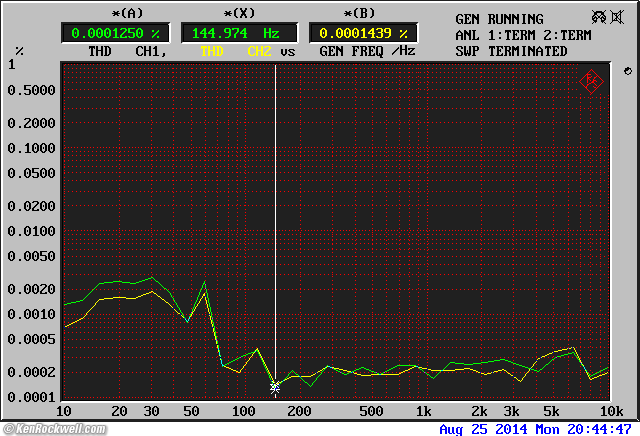
HMA-8500 Mk II THD at 1 W.
This is zippo, Notation the expanded scale at the bottom to 0.0001%, far less than the remainder of well-nigh analyzers. The apparent increment at the low frequencies is again actually hum — and it's still completely negligible.
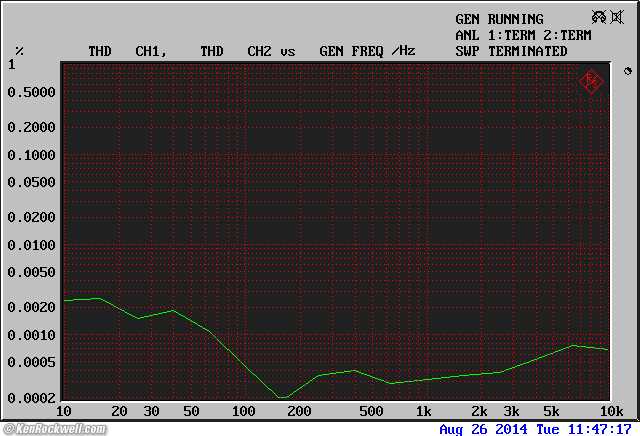
HMA-8500 Mk II THD at i Westward into 4 Ω.
Distortion is a little higher into 4Ω, only not past much.
Harmonic Distortion at 100 watts
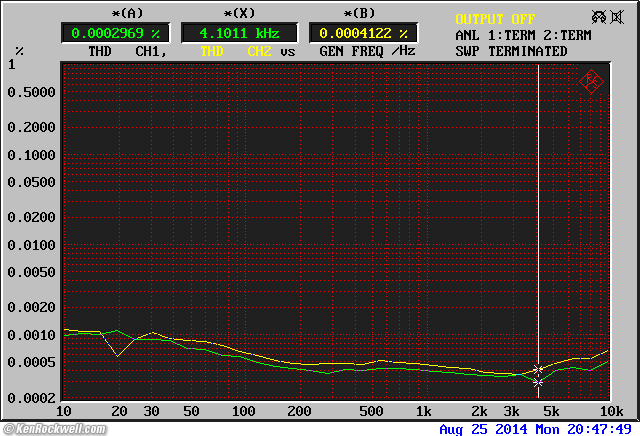
HMA-8500 Mk II THD at 100 Westward.
Note the expanded scale at the bottom at 0.0002%. This is the lowest I've measured as of August 2014.
Harmonic Distortion Components at ane watt
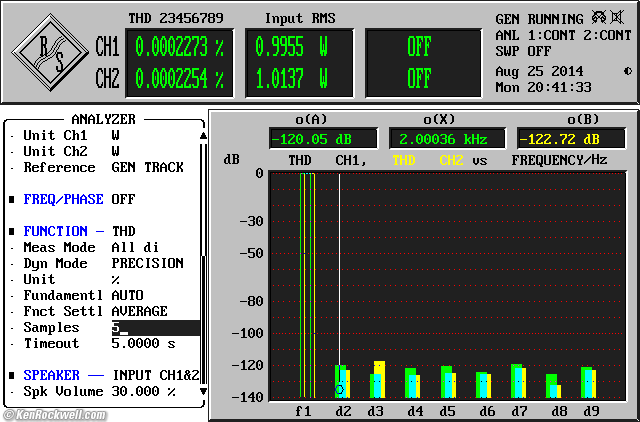
HMA-8500 Mk Ii harmonic distortion content at 1 Westward.
This is nothing; less than most analyzer's limits.
Harmonic Baloney Components at 100 watts
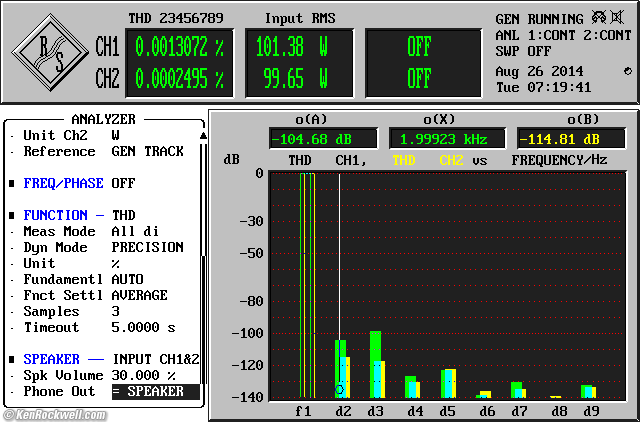
HMA-8500 Mk II harmonic distortion content at 100 Due west.
This is still nix, and not how the simply distortion components are second and third harmonics.
19+20 kHz Difference-Frequency Distortion (DFD)
per DIN IEC 268-3 or 118:
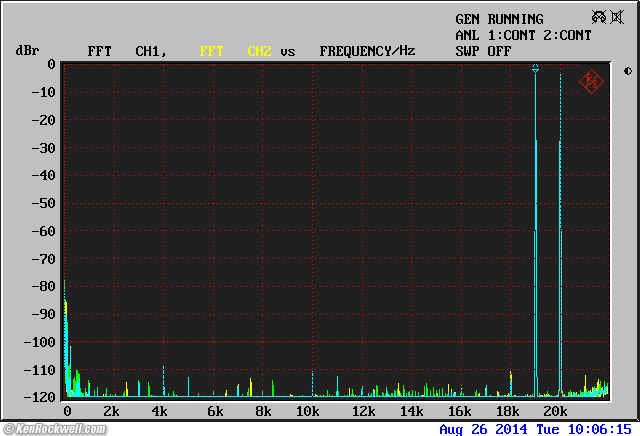
DFD at 1 W RMS total output.
This is superb. Only the Sony TA-N77ES measures better hither.
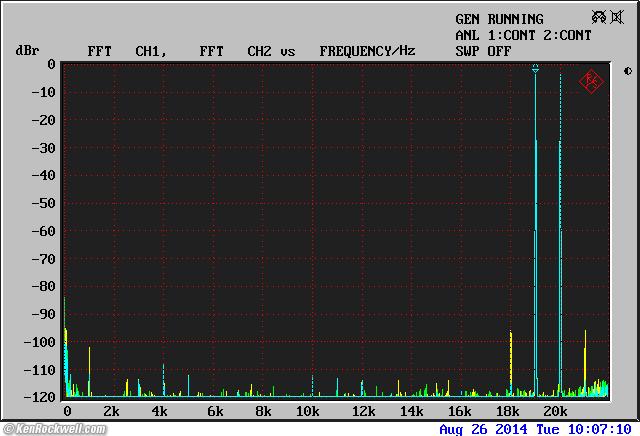
DFD at 10 W RMS full output.
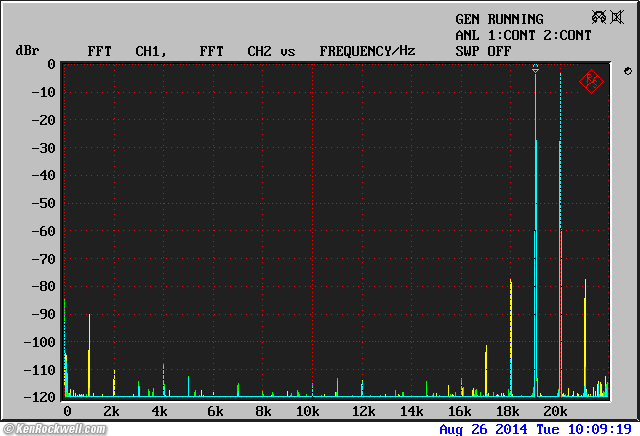
DFD at fifty Due west RMS total output.
Oddly the right aqueduct is worse than the left channel at high power at loftier frequencies, simply don't worry, since not merely is this withal superb performance, if yous e'er actually used this much output at 19 kHz, you'll fry your tweeters instantly.
Headphone Output measurements summit
The headphone output is simply fed from the amplifier'southward outputs via a resistor.
More precisely, each headphone channel is fed from the output bus via a relay and and then three 1kΩ 1/2 watt resistors in parallel (333 Ω effective). (The speakers are fed from this bus via other relays.)
The headphone output is active regardless of the settings of the speaker switches, merely is muted as the amp turns on.
Even though Hitachi didn't carp to provide a dedicated headphone output amplifier, they did include a few relays so that if you run the HMA-8500 Mk II in BTL (bridged mono) mode the headphone output will revert to proper mono, with both channels in-stage.
The HMA-8500 Mk II is then quiet that there is no dissonance audible with sensitive 58Ω headphones like the Senal SMH-1000, and of grade packs plenty power to melt just virtually any headphones if y'all try.
It should put out 25 Five into 600 Ω (over 1 watt or +xxx dBm).
It should put out 3.5 V into 32 Ω (380 mW or +25 dBm).
Meters measurements top
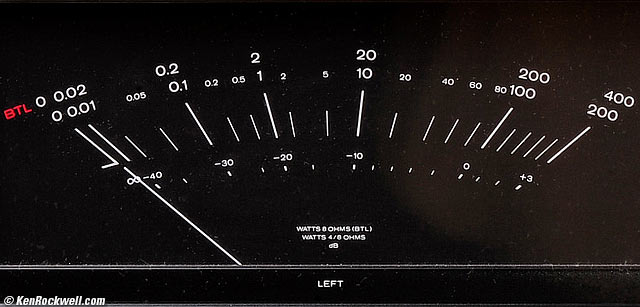
Hitachi HMA-8500 Mk II Meter.
The meters, the nigh outstanding thing almost this amplifier, are big and legible.
The needles move backside the clear plastic scales. The scales and needles are lit past four fourteen V, eighty mA, 4mm diameter incandescent lamps with leads, held in by greenish silicon boots, which give the meters a lite green glow. Each side uses two bulbs in series connected across 26VDC.
The meters have VU ballistics and are fed from a half-moving ridge quasi-peak detector. They read near one-half fashion between average and true peak ability every bit read on the Technics SH-9020. Funny thing with the VU ballistics is that fifty-fifty if the Hitachi reads the peak well, its needles get at that place well-nigh a tertiary of a 2nd behind the SH-9020.
The meters read the voltage level of the output omnibus, as fed from the headphone relay.
The meters are more guides than precision instruments. They read only the positive half of the waveform, and they take plenty of overshoot.
Like the meters used past the Krell in Forbidden Planet, they barely movement at all when played softly or at reasonable levels. This is why these large meters were so short lived: once people realized that they rarely used any power at all, they realized they either never needed big amplifiers, or that by just turning it down a few clicks even a small amplifier is all they would e'er need.
Meter Accurateness
| Actual output RMS | Meters Read |
| 0 | 0 |
| 10 mW | 10 mW |
| 100 mW | 95 mW |
| i W | 0.92 W / -21 dB |
| x W | 9 Due west |
| 100 W | 97 Due west |
| 153 W for 10 mS | 80 W |
| 120 Due west | 115 W |
| 150 W | 150 W |
| 200 W | 190 Due west |
Frequency Response
From DC input, read at meters:
-ten dB at one.0 Hz
-3 dB at 4.2 Hz
-1 dB at 8.5 Hz
Flat 20 - 32,000 Hz
-1 dB at ninety,000 Hz
Burst Response
Measured at 100 West at 60 bpm or 1 burst per second. The overshoots were greatest at 30 BPM (1 burst every 2 seconds).
| Flare-up elapsing | Outburst Duty Cycle | Metered Per centum Power | Metered Decibels |
| ane,000 mS | 100% | 100% | 0.0 dB |
| 500 mS | l% | 145% | +1.7 dB |
| 200 mS | twenty% | 170% | +2.ane dB |
| 100 mS | ten% | 150% | +1.seven dB |
| l mS | 5% | 120% | +1 dB |
| 20 mS | 2% | 80% | -one dB |
| 10 mS | ane% | 50% | -three dB |
| 5 mS | 0.five% | 20% | -7 dB |
| 2 mS | 0.2% | ii% | -17 dB |
| 1 mS | 0.ane% | 0.i% | -thirty dB |
Thus it'due south a roughly peak-reading half-wave meter and it has VU-style display ballistics. It'southward similar to the Sony TA-N77ES, except that the Sony has much quicker peak-agree capture, and much poorer depression-frequency response.
This roughly 10 mS elevation response is near the same as our ear'southward perception of clipping distortion, in other words, shorter periods of clipping ordinarily aren't noticed (even if your tweeters volition feel it).
With 10 mS bursts at 145W, the meters read 80W.
Measured Power Consumption measurements top
The HMA-8500 Mk 2 runs relatively hot. Proceed it well ventilated.
Hitachi says leave at least 25 cm (x") in a higher place it for ventilation.
Even well ventilated, the sticker warns not to bear upon the top cover, and it does become hot enough that I wouldn't want to keep my hand on it too long. This is normal.
| Output per aqueduct, both driven | Power Consumption | Efficiency |
| Power off | aught. | north/a |
| Idle, cold | 86 W | 0% |
| Idle | 91 W at 119.8 VAC | 0% |
| 10 mW | 92 Due west at 120.two VAC | 0.022% |
| 100 mW | 95 W at 120.2 VAC | 0.21% |
| ane Due west | 111 W at 119.6 VAC | 1.8% |
| 10 W | 179 Due west at 119.1 VAC | 11.1% |
| 100 Westward | 407 Westward at 119 VAC | 49.1% |
| 116 West | 419 W (four.34 A) at 120 VAC | 55.3% |
| 135 W (4Ω) | 586 W at 120 VAC | 46% |
BTL (mono) Performance measurements superlative
BTL means bridged transformerless, or mono performance.
In BTL mode, gain is 34.97 dB.
fifty.4 mV gives ane W output into 8Ω.
809 mV gives 251 W output into 8Ω at 0.ane% THD.
I didn't test burst power in BTL.
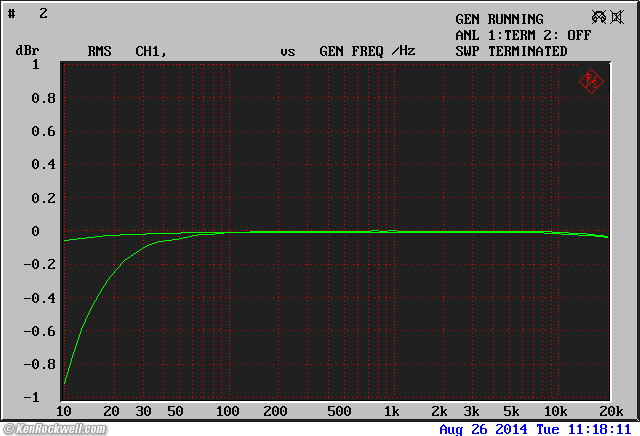
HMA-8500 Mk II frequency response driving 8Ω in MONO mode (DC and AC-coupled inputs shown).
Frequency response is unchanged.
THD runs around 0.001% at i Due west.
In BTL mode, both meters read the aforementioned, and set up themselves to the 4Ω setting, significant each reads properly for 8Ω when driven by the BTL amplifier.
The dual meter scales are disruptive. Ignore the BTL scale except in BTL (Mono) style. You lot read 8Ω and 4Ω speakers off the same lower scale; the meter changes its calibration internally equally you prepare the 4Ω/8Ω switch.
Usage top
Intro Specifications Measurements Usage Recommendations More
The amp's protection relays don't click on for 5-ten seconds afterwards plow-on. While the protection relay is cutting-off for whatsoever reason, the meter range LED blinks.
The speaker outputs look like real iii/four" banana jacks, but they aren't! They are only plastic knobs trying to expect like bananas. They are at slightly more than than 3/4," and even after you muscle a standard dual plug into them, at that place';s no sound considering they take no metal in them! The red and blackness caps are only handles to screw-in wire. Pooh.
This amp gets hot; let it sit past itself and don't stack other components on top of information technology.
BTL (mono) fashion uses merely the LEFT input and the 2 red B speaker terminals.
Protection trips the speaker relays if the amp detects either that it'due south safe-operating surface area has been exceeded, or if there's besides much DC on the speaker outputs. Because of this, the amp trips the relays at 100 W into 8 Ω at sine-wave frequencies of less than ii.5 Hz.
DC detect sums channels, may non work in BTL
Recommendations top
Intro Specifications Measurements Usage Recommendations
The HMA-8500 Mk II measures extraordinarily well and sounds cracking.
What the measurements tell united states when looking at 4Ω performance is that, as many Japanese amplifiers, this is a lab queen. That ways information technology's bred to examination well, and less and so to drive existent loudspeakers. Oddly the little Hafler DH-120 can belt out more height power into 4Ω than this much larger amplifier which uses twice equally many of the aforementioned output devices!
It doesn't put out much more power at 4Ω than 8Ω, and its 4Ω output power doesn't vary much with ability supply input voltage.
This HMA-8500 Mk II sounds wonderful, even with 4Ω speakers like the B&W 802, but for maximum power, an American amplifier volition evangelize much more into 4Ω.
This amplifier works dandy into 4Ω, but information technology's much happier at 8Ω.
I love this thing, even with my 4Ω speakers. It looks groovy with its big meters; I only realize that it really only puts out nearly 140W outburst power into 4Ω or 8Ω.
Tell yourself it's a Class A amplifier, which most of the time it is. That'south why information technology runs so warm.
Aid me help you top
I support my growing family through this website, every bit crazy as it might seem.
The biggest help is when you use any of these links when you lot get annihilation, regardless of the state in which you live. It costs you goose egg, and is this site'due south, and thus my family'due south, biggest source of support. These places take the best prices and service, which is why I've used them since before this website existed. I recommend them all personally.
If yous find this folio as helpful every bit a book you might take had to buy or a workshop you lot may have had to accept, experience free to help me go along helping everyone.
If y'all've gotten your gear through 1 of my links or helped otherwise, you're family. It'due south peachy people like you who allow me to keep adding to this site full-time. Thank you!
If you haven't helped even so, please do, and consider helping me with a gift of $5.00.
As this page is copyrighted and formally registered, it is unlawful to make copies, specially in the form of printouts for personal utilise. If you wish to make a printout for personal use, you are granted i-fourth dimension permission only if you PayPal me $5.00 per printout or function thereof. Thank y'all!
Thanks for reading!
Mr. & Mrs. Ken Rockwell, Ryan and Katie.
Habitation Donate NewSearch Gallery Reviews How-To Books Links Workshops About Contact
Source: https://www.kenrockwell.com/audio/hitachi/hma-8500-mk-ii.htm
0 Response to "Hitachi Hma-8500 Mk Ii Stereo Power Amplifier Review"
Publicar un comentario